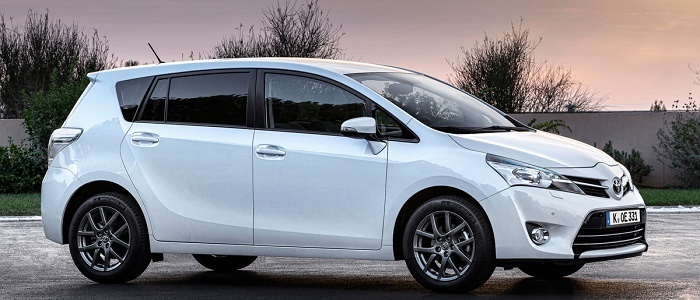
Toyota Verso 1.6 D-4D - economical for the trip
Family car model? Today, most of us will think of an SUV. But a few years ago, the answer would have been very different. Minivan. Let's see what the state of this segment is now, or rather, how is the Toyota Verso doing and does it still hold its place in the automotive world?
Sometime in the mid-s we experienced a flood of multi-purpose vehicles known as minivans. Every major manufacturer had at least one such model in stock. A little more, in several sizes - from small cars that hardly fit into this canon, to cruisers like the Chrysler Voyager. Large dimensions and, accordingly, more space inside most often convince you to buy. On the plus side, there were also probably numerous storage compartments, places for drinks and, probably most importantly, two extra seats. Today, this genre does not seem to be as popular as it used to be. It was replaced by the ubiquitous pseudo-SUVs, called SUVs and crossovers. Today's idea for the family proved to be more effective - it offers what a minivan does, including seven seats, while at the same time, the increased suspension allows it to go a little further on the campsite. How then can minivans protect themselves?
Sharp forms
The Toyota Verso was created from the merger of the Avensis Verso and Corolla Verso models. As SUVs, including the RAV4, have become more popular than minivans, shrinking the minivan lineup has been a natural move. So Toyota combined two models into one - Verso. This one has been on the market since 2009, and in 2012 it underwent a really specific facelift, during which as many as 470 elements were changed.
The changes are most noticeable from the front. Now it is more aggressive and no longer tries to be like the third generation Toyota Avensis. The headlights have merged with the grille, but in a more familiar way than on other models of the brand. By the way, their shape is now much more dynamic, so that the “superdaddy” car, as Toyota promotes it, is certainly not associated with boredom. Less happened in the rear and Toyota Verso it is more related to its predecessors with characteristic white lamps. The side line, as befits a minivan, has a large area due to the higher roofline. Despite this, the high-mounted lower window line, which slopes upward at the rear, also gives the car body dynamics, making it one of the most interesting minivans on the market. And suddenly it turns out that the minivan does not have to be boring. At least outside.
clock in the middle
Having taken a seat in the cabin, we immediately pay attention to the instrument cluster, which is located in the center of the dashboard. The advantage of such a solution, of course, is a larger field of view, but it is definitely not natural for the driver - at least not immediately. We end up looking at the black plastic blanket every now and then, hoping to see speed or at least fuel level there. I can't count how many times I've made sure my headlights are off at night because it's dark on the dashboard - all I had to do was look a little to the right. I want to add that the position of the instrument panel is so deeply rooted in the mind of the driver that after driving almost 900 km nothing has changed here and the reflex remains.
The driver's seat in the minivan is raised to provide greater comfort when traveling long distances. In fact, it will not be difficult to roll up kilometers of roads here, but the fabric seats are already too tough after a long drive. The steering wheel has a standard set of buttons for hands-free operation and the Touch & Go multimedia system. This system is mainly used to control the phone and music, although we can also find navigation there. It doesn't look particularly pretty, but it works thanks to a clean interface. As long as we have up-to-date maps. Of course, there is also dual-zone air conditioning on board or even a keyless entry system to the car.
The minivan is first and foremost practical. There are quite a few lockers here, as evidenced by the presence of not one, but two chests in front of the passenger. There's plenty of room for drinks, too, and even those in the last row of seats have their own two holders. The second row seats consist of three separate seats, each of which can be reclined separately, while the third row accommodates two additional seats. It almost literally “hides” because when folded it forms a flat luggage compartment. For long trips, however, it is better to go with a five, because then we will have a luggage compartment with a capacity of 484 liters up to the seat line and 743 liters if we stuff everything up to the roof. Folding the rear seats effectively limits that space to just 155 liters.
Base diesel
The 1.6 D-4D version, which is the weakest engine in the offer, was submitted for testing. Toyota Verso. Contrary to the appearance, it is quite enough for a peaceful journey, although the power it develops is only 112 hp. at 4000 rpm. It will not allow you to drive dynamically with a full package of passengers and luggage, but high torque, 270 Nm at 1750-2250 rpm, reduces the effect of load on driving performance. After all, a driver carrying 4 or even 6 people should not take too much. It took us 0 seconds to go from 100 to 12,2 km/h, but that flexibility is what we mostly want on the road. In fourth gear, acceleration from 80-120 km / h takes 9,7 s, in fifth - 12,5 s, and in sixth - 15,4 s. In short - you can do without reducing overtaking, but in sixth it is better to have more seats .
The manual six-speed has long jack paths, but we don't get the wrong gear or something awkward. The weight of the car is 1520 kg, but unlike SUVs, it is suspended lower, which means that the center of gravity is closer to the asphalt. This is reflected in good driving characteristics, such as the fact that the body does not roll too much to the sides and quite willingly obeys the driver's commands. Of course, within the limits allowed by the laws of physics and engineering solutions that try to deceive them. And these are not very complicated, because these are classic McPherson struts and a torsion beam. It sometimes bounces on bumps, although the suspension catches bumps well.
Combustion in combination with a large fuel tank - 60 liters - allows you to overcome the milestone of 1000 km on one tank. Riding at speeds of 80-110 km/h costs us an average of 5,3 l/100 km, and the entire three-hundred-kilometer route was covered with an average fuel consumption of about 5,9 l/100 km - with a relatively quiet ride. The built-up area requires about 7-7.5 l / 100 km, which is also not a jump in our bank account.
For the family? Of course!
Toyota Verso this is a decent car designed for family trips. It has a lot of space inside, comfortable seats and a large trunk that hides two places if necessary. It is worth noting that we do not have to bother with any system for extending and folding seats - they are used when necessary and do not interfere most of the time. Verso also shows that minivans still exist, but of course for a narrower group of customers. If you can just give the clock in the center console a chance and get used to it somehow, the Verso could be quite an interesting proposition.
The offer is also interesting because of the price. Base model with a 1.6 petrol engine with 132 hp. already costs PLN 65, although we could probably try to get additional discounts. The cheapest diesel, i.e. the same as in the previous test, costs a minimum of PLN 990, although in higher equipment versions it will be PLN 78 and PLN 990. The engine range is limited to two more units - a 92 hp Valvematic gasoline engine. and diesel 990 D-106D with a power of 990 hp. Apparently, it is supposed to spare here, and performance has faded into the background. Minivans are certainly giving way to SUVs today, but there are still drivers who prefer this type. And it's not that hard to find them.
